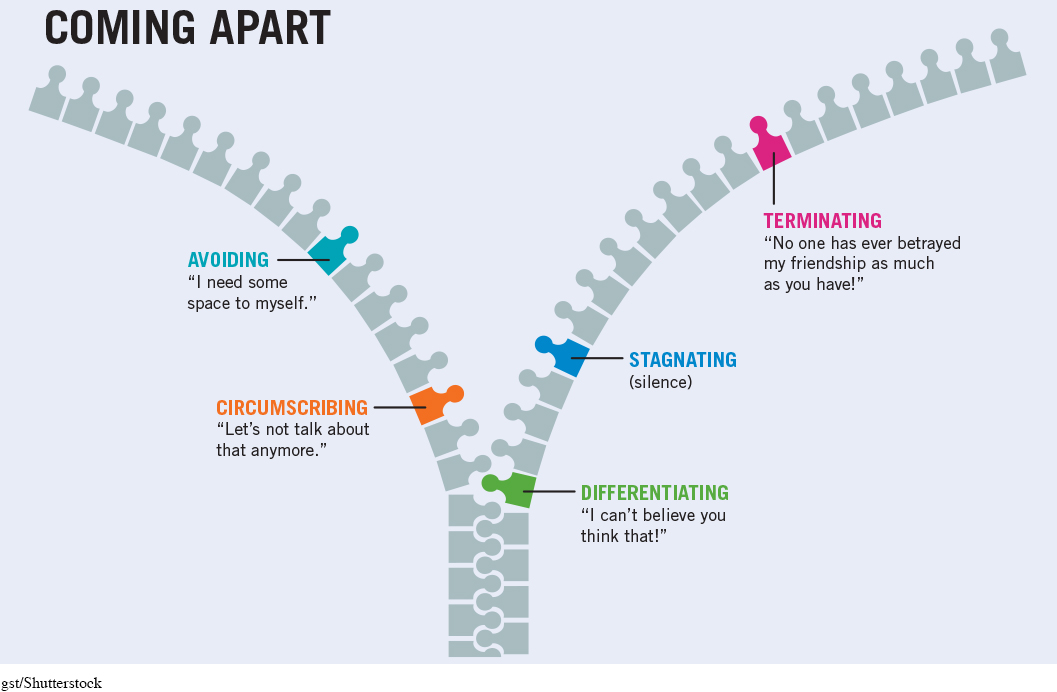Coming Apart
In most of your relationships, you will also experience stages of coming apart—
Like coming together, coming apart unfolds over stages marked by changes in the partners’ thoughts, feelings, and communication. Many romantic partners, family members, friends, and coworkers experience some of these stages at various points in their relationships. Again, your relationships may go through some, none, or all of these stages. In fact, not all relationships that begin to come apart result in a permanent ending of the relationship. Sometimes, with enough effort, people can resolve their differences. Other times, ending the relationship is the right thing to do because the people involved have either grown apart or permanently lost interest in each other. No matter the situation, the stages of coming apart often involve intense emotional pain that can make it difficult for the individuals involved to communicate competently with each other. This is why it is important to know and understand these relationship stages, so you can better handle them as they come up.
Differentiating. In all relationships, partners share differences as well as similarities. But during the first stage of coming apart, differentiating, the beliefs, attitudes, and values that distinguish you from your partner come to dominate your thoughts and communication (“I can’t believe you think that!” or “We are so different!”).
236
Most healthy relationships experience occasional periods of differentiating. These moments can involve arguing over what the partners see as conflicting viewpoints, tastes, or goals. But you can move your relationship through this difficulty—
Circumscribing. If one or both of you respond to problematic differences by ignoring them and spending less time talking, you enter the circumscribing stage of coming apart. You actively begin to restrict the quantity and quality of information you exchange in the relationship, creating “safe zones” in which you discuss only topics that won’t provoke conflict. Common remarks made during circumscribing include “Don’t ask me about that” and “Let’s not talk about that anymore.”

Stagnating. If circumscribing becomes so severe that you and the other person have almost no safe topics to talk about, communication slows to a standstill, and the relationship enters the stagnating stage. You both presume that communicating is pointless because you believe it will only lead to further problems. People in stagnant relationships often experience a sense of resignation; they feel stuck or trapped. However, some stay in the relationship for months or even years. Why? They may believe that it’s better to leave things as they are than to put in the enormous effort needed to end or try to rebuild the relationship, or they simply may not know how to repair the damage done to their earlier bond.
237
 LearningCurve can help you review! Go to macmillanhighered.com/
LearningCurve can help you review! Go to macmillanhighered.com/
Avoiding. During the avoiding stage, one or both of you decide that you can no longer be around the other, and you begin distancing yourself physically. Some people communicate avoidance directly and verbally (“You are no longer my son, and I want no further contact with you!” or “We’re no longer friends”). Others may do it by spending more and more time away from their partner—
Terminating. In ending a relationship, some people want to come together for a final encounter that gives a sense of closure and resolution. During the terminating stage, former partners might discuss the past, present, and future of the relationship. They often describe their past relationship by making accusations (“No one has ever betrayed my friendship as much as you have!”) or expressing sadness over what’s been lost (“I’ll never be able to find someone as perfect as you”). Their verbal and nonverbal behaviors reveal a lack of intimacy—
Many people find terminating a relationship painful or awkward. It’s hard to tell someone that you no longer want to be involved with him or her, and it’s equally painful to hear it. But by drawing on all you’ve learned about communication, you can survive this dreaded moment. Use skills from Chapter 2, such as empathic concern—